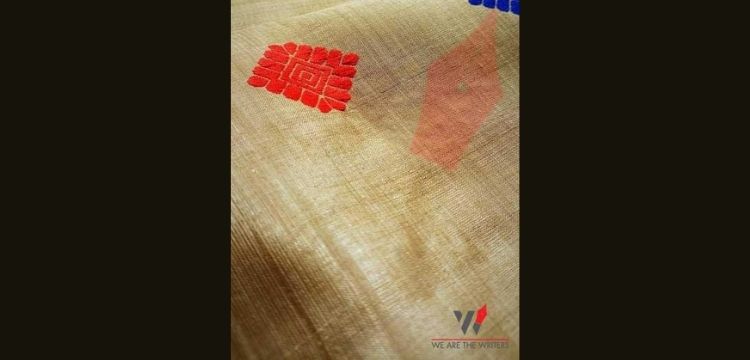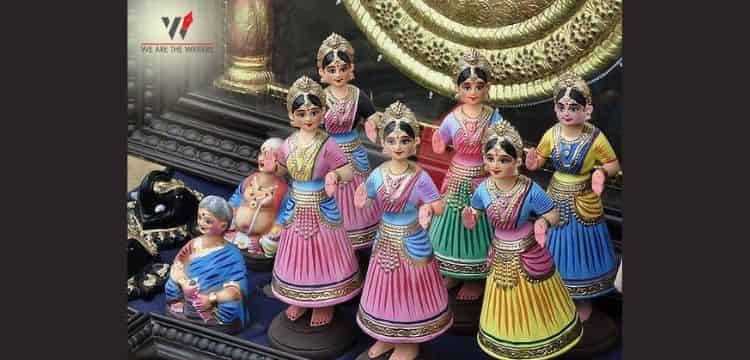There is something about the diverse culture and heritage of our country that makes it unique and piques the interest of everyone around the world. From possessing a rich history to displaying exceptional arts & crafts, handloom skills, every state in India comes with its share of stories and distinctness. The handloom industry represents the glory of the traditional, unique, and elegant craftsmanship of India. The creativity of creating compelling textures varies from state to state because of the region and cultural influences.
The northeast region of India is proud to have the seven sisters(Arunachal Pradesh, Meghalaya, Manipur, Mizoram, Nagaland, and Tripura) that have their tradition of handloom dating back to several centuries. Tripura is one such state with mastery over vibrant weaves, exquisite designs, and intricate embroidery patterns in the handloom sector.
Table of Contents
Tripura- The Land of Arts & Crafts

Tripura, located in the northeast region of India, is majorly known for its handlooms, silk, cane, and bamboo works in the art and craft industries. It is the single largest and perhaps the oldest state in the Handloom industry. Tripura has its root in the traditional front because of the large tribal population; however, it perfectly coexists with the urban areas. The amalgamation of new techniques along with the original art style reflects the intrinsic art of craftsmanship and uniqueness of the people.
Despite being a state with a large tribal population, Tripura is also one of the most literate states (as per census 2011), with a literacy rate of 87.75%. They display strong dedication, cultural motives, and willingness to freely adopting motifs and techniques from each other’s traditions to enrich their own. Apart from playing a crucial role in boosting the state’s economy, the handloom industry also gets considered as the mode of secondary employment and income for domestic cultivators.
Importance of Handloom

To speak more of the cultural aspect and the handloom industry of Tripura, the people in the tribal region consider weaving as an integral part of their lives. The handloom industry is more like a tradition that gets passed down from generation to generation. The people produce their own clothes with beautiful designs, unique color combinations, and enduring texture. The self-sufficiency in clothing comes from the fact that handloom and weaving traditions hold profound values, especially for the women of the tribal Tripura. In fact, the women dedicate themselves to weaving so much that they don’t get considered eligible as a bride if they don’t know the practice.
Today, Tripura has made itself a domestic and world-renowned hub for authentic handloom art. There is a lot of demand for Tripura handloom(Risa) in the International market, which has put Tripura’s dedicated craftsmanship on the global map. Also, the Risa manufacturers and weavers get awarded on major platforms for their exceptional design.
Handloom Weaving

Most of the handloom work in the Tripuri community gets done through the traditional Loin Looms. These traditional age-old looms have a simple design, are cheap, and easily operatable. The looms are portable as they don’t have a fixed frame or a heavy structure as they get built from bamboo and wood. Moreover, these looms offer the flexibility of design for the handloom artist.
A common Lion loom or a backstrap loom consists of elements like the front bar, breast bar, swords, healt bar, circular bamboo bar, lease rod, the back strap.
The weaver can use this loom anywhere because of its portability factor. The weaver wears a backstrap to adjust themselves according to the requirement and then weave. This factor is the reason why the lion loom is also called a backstrap loom. The weaver adjusts the backstrap and keeps the foot on the footrest, which gets used to adjust the tension.
The weaving gets carried out by the shedding, picking, and beating motion. Lift the healt bar with the left hand while pressing down the circular bamboo bar with the right hand at the same time. After that, a sword gets placed in the shed and kept vertical T.
The yarn material gets passed from the right side by the right hand with the help of a shuttle (a bamboo piece that consists of yarn) and picked up by the left hand. Then the weft gets thrashed by the sword.
After thrashing, the sword gets taken out, which results in the formation of the center shed. The same process gets repeated again and again until it results in the formation of patterns.
Materials and equipment necessary for weaving comprise cotton, spindle, spinning machine, bow, and a loom. The most common raw materials that get used in the process are acrylic, cotton, and at times, silk. The yarn comes from Assam, Bengal, and Southern India.
Traditionally a cotton yarn cultivated in the jhoom fields is used, which gets hand-spun and naturally dyed by the weavers. This entire process affirms that weaving is not just a production process but a form of art that requires precision!
However, recent times have witnessed a gradual shift of weaving materials from cotton to acrylic yarns. The cause of this shift can be associated with various circumstances like- the non-availability of high-grade quality cotton, durability, and quick washing of the acrylic yarns. All of those factors make acrylic yarn the preferred yarn type for weaving.
Handloom Products

The handloom items include Riha, Lungi, Sari, Bed Sheets, and scarves with Tripuri motifs, distinctive in the Kuki, Lussai, and Reang tribes. The vertical and horizontal stripes with embroidery spread in different colors are the main highlight of Tripuri handlooms. It is a treat to witness high-quality patterns and textures coming from various Tripuri tribes!
Apart from the traditional products, the other category of popular handloom items includes lasingphee, shoulder bags, table mats, cushion covers, and canvas for holding chairs.
Cultural Reflection

The handloom of Tripura beautifully reflects three cultures- Tribal, Bengali, and Manipuri. The practice of handloom weaving among the Tribals and Manipuris is limited to women, whereas both men and women practice this art in the Bengali community. It is the incredible sense of aesthetic beauty and the magic of experienced hands that let the vision or concept blossom into an artistic reality.
One of the interesting characteristics of the handloom culture is that each tribal society has its set of distinct patterns that distinguish them from the others. The design patterns are so unique that anyone can identify the clan of the person. However, with the prevailing intertwining of people across clans, the designs have seen a fusion of patterns.
Clothing Style

The people of Tripura have a distinct style for both men and women. The women wear a traditional piece of clothing- Risa, which covers the upper half of the body. The Riha adorns exquisite tribal patterns, horizontal or vertical stripes, floral patterns, or simple dots in the most common color background of black & blue or red.
Risa is a part of the traditional clothing that gets worn around the chest by wrapping it twice for support and protection. It is also an article of symbolic clothing in ‘Risa Somnai’ panda, a ceremony to celebrate the adolescence of the girl child. The family and close members come together to worship Lampra God and wish for the child’s wellbeing. Risa also gets used as waist support, turban, baby holder, muffler, headscarf, and is also used for honoring guests and as an offering in Pooja.
While Rikutu and Risa are for the upper body, Rignai is for the lower half of the body. This particular handloom has a variety of designs, with up to 240 designs originating from the times of Maharaj Subrai or Trilochana. The story behind the 240 designs goes like this: the king of Tripura married women who invented new designs, and through them came a variety of rignai. However, most of the designs got lost over time. With a design that dates 4000 years back, a Rignai gets made according to the women’s height. It gets used as a Chandua, carpet, and in worship.
The Men wear Duti Borok for the lower part and Kamchwlwi Borok(traditional Tripuri shirt) for the upper part of the body. Men can also modify Risa and wear it as a turban. However, the attires now reflect the influence of modern culture, which elevates the look of the attire while keeping its core truly traditional.
Vocal for Local

Even though handloom products are known globally, we believe that a lot of beautiful brands get unnoticed. This problem occurs because of the limited exposure and highlight to the local brands within the domestic grounds. We Are The Writers charged ahead with a mission to showcase the richness of the northeast handloom through a first-of-its-kind initiative.
To celebrate National Handloom Week (7-14th of April), We are the Writers took a noble initiative- “Threads from the Northeast” to bring forward the rich heritage of the North-eastern states. This one-of-a-kind initiative highlighted the handloom sector of India by giving various start-ups and individuals a platform to promote the handloom industry through their business.
Through this event series, a lot of outstanding handloom start-ups got discovered. And the winner of the event emerged as ILIKA.
The brand is connected to its roots just as its name reflects, which brings out the true essence of the northeast culture.
ILIKA offers a variety of patterns, some of which include Rabha pattern weave, Gero Mishing pattern, and many more. Apart from Sarees, ILIKA also offers Gamucha fabric clutch bags, dresses, and blouse pieces with different motifs and symbols.
Also, the brand is ethically responsible as it uses organic materials for most products. Making products in small quantities with up-cycled products helps to preserve locally produced artisanal traditions.
You can check out their products on their Instagram and Facebook Handles.
Conclusion
We live in a society that displays unity in diversity. We should take pride in the culture that our country offers and support the local environment-conscious brands. Remember, your effort is all it takes to acknowledge the authentic home-grown brands. You can always look up and support local brands on social networking sites and help them grow!





 WhatsApp
WhatsApp